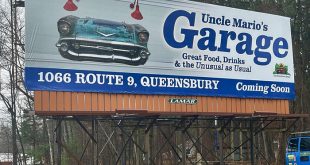By Gordon Woodworth, Chronicle News Editor
The Glens Falls City School District is asking voters to approve spending $691,200 to install permanent lights on its football field, but the plan is drawing some high-profile opposition.
The proposition, set for a May 16 vote, is separate from a $17.55-million capital proposition for maintenance and repairs to all of the district’s buildings.
Both propositions must pass for the lights to be installed, Superintendent Paul Jenkins told The Chronicle.
He said state aid will cover 75% of the total $18.3-million in projects, and the district would use $1.8-million in fund balance. So, he said, taxes will not increase if the two propositions are approved because they won’t add to the district’s debt load.
“The board wanted to separate the lights from the rest of the project because we all knew that some residents had voiced concerns about having permanent lights installed,” he told The Chronicle Tuesday.
Those concerns were voiced in February 2010 when the Glens Falls Grandstanders wanted to raise $200,000 to install permanent lights. Some neighbors, including former Glens Falls Mayor Robert Regan and then-school board member Todd Feigenbaum, objected.
At the time, Mr. Feigenbaum said, “In my opinion, the district did represent to the public that lights would not be put up for the foreseeable future…When you are asking for support for a project, and when you tell the voters no lights, I think they have a reasonable expectation that they are being honest.”
Seven years later, Mr. Feigenbaum and Mr. Regan still have concerns.
Mr. Feigenbaum has disseminated an email urging a vote against the lights.
The letter was also signed by former school board president Dr. Anna Poulos, former school board members Shirley Berger and Matt Conrick, as well as Mr. Feigenbaum and Mr. Regan.
Mr. Jenkins said he met with the two men on March 20. He said, “They were concerned about additional traffic and noise.”
Their letter, addressed “To The Voters of the Glens Falls City School District,” asks recipients to “please forward this email to every voter you know in the Glens Falls City School District. Help keep our school district’s budget priorities focused on improving instructional programs and fostering student success. Oppose irresponsible spending by voting NO on May 16th to install unnecessary field lighting.”
The letter says the district wants to spend money on lights for an athletic field while not fully funding academic priorities, and suggested the high school teams can use East Field, which already has lights.
Mr. Jenkins responds that traveling to off-campus facilities for games and practices “often creates significant expenses for athletic departments, can create additional expense and inconvenience parents/fans, often limits revenue gained from ticket/concession sales, typically creates scheduling difficulties,” and he notes the district would have to pay to rent East Field.
The critics’ letter argues that beyond the cost of installing the lights, additional expenses like electricity, extra chaperones and additional police “all add up to a significant amount of money.”
Mr. Jenkins responds that for 25 years the lights will cost nothing for maintenance and use $8.50 of electricity per hour.
“Practices, as well as many games, will not require extra chaperones or police presence,” Mr. Jenkins notes.
The letter states that “the impact of lights will be felt, seen, and heard across many neighborhoods in the City.
“The 80 foot tall towers with banks of lights will be visible, in the day as well as the night. They will be seen from as far away as the Northway — and from many parts of the City. This height is unacceptable in a residential neighborhood.”
Mr. Jenkins says the lights “will not be seen across many neighborhoods. This statement may have been accurate before 2004, not with the new lights in 2017.”
He says “poles of this height, as well as higher, are frequently used in residential neighborhoods…Taller poles allow for better aiming angles, less spill light, and less glare. They also allow for better uniformities on the field and track.”
The opposition letter argues that “the use of alcohol has historically been more of a problem with night games. Some school administrators have been opposed to night games because of the increased behavioral problems that occur.”
Mr. Jenkins responds, “This claim is often made but I have never seen any data to support [it]. I believe it’s false. I would argue the number of schools that are opposed to night games due to potential issues is very small.
“I would argue having students running around/driving around the neighborhoods is more difficult to supervise and leads to more problems annually than issues that arise because of night games.”
Copyright © 2017 Lone Oak Publishing Co., Inc. All Rights Reserved.
 Glens Falls Chronicle Serving the Glens Falls/Lake George region; Warren, Washington and northern Saratoga counties since 1980
Glens Falls Chronicle Serving the Glens Falls/Lake George region; Warren, Washington and northern Saratoga counties since 1980


